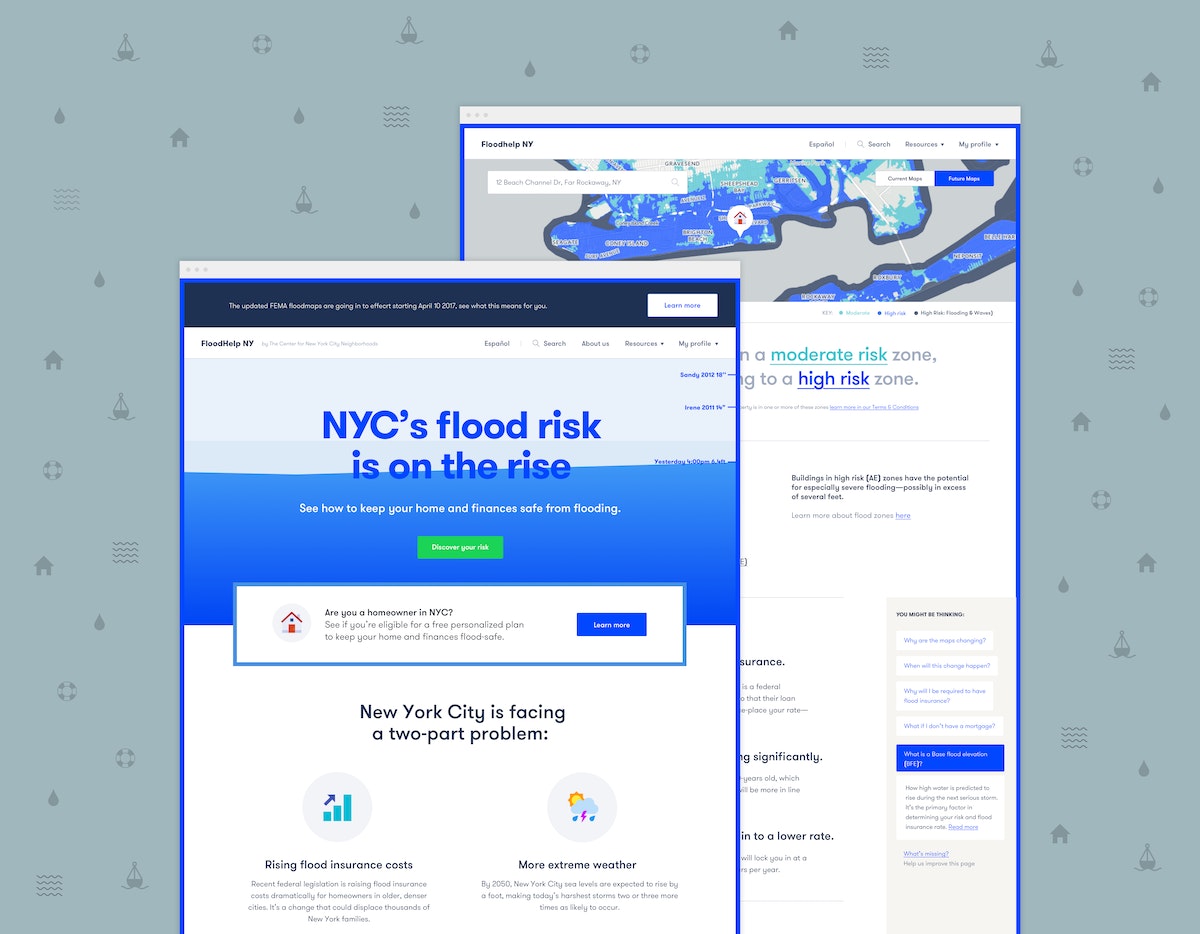Preparing New Yorkers for future flooding

For homeowners trying to navigate the complicated and often confusing landscape of increasing flood risk and federal flood insurance, every step toward simplicity is critical. IDEO’s redesign of FloodHelpNY provided just that, a user-friendly, simple, one-stop shop for flood risk and insurance information.
New Yorkers are a tough lot, but damaging coastal storms will continue to test their resilience. More than 400,000 people live within the city’s floodplain and are at physical and economic risk. In the face of both natural and manmade challenges—from superstorms to confusing insurance regulations—many New Yorkers are not aware of their flood risk, or even that they should be thinking about it at all.
The Center for NYC Neighborhoods‚ a nonprofit that champions affordable homeownership for middle- and working-class families and communities, engaged IDEO to create a resource that could help New Yorkers keep their homes and finances safe. Launched in September 2016 with funding from New York State's Governor's Office of Storm Recovery, FloodHelpNY is an expansive platform that dismantles the complexity surrounding flood insurance and gives homeowners clear and simple guidance for assessing their flood risk and taking action toward resiliency.

Facing the complexities of insurance policy, shifting flood regulations, climate change, and citizen engagement, the design team began by engaging two vastly different groups of New Yorkers—those who had been battered by past storms and those not yet affected. Homeowners in the first camp were angry and frustrated by a system that had let them down after Superstorm Sandy. Homeowners in the second camp were simply unaware of their risk and had little idea of what might happen. The right design solution needed to encourage both groups to take action and learn about flood risk and insurance regulations, while also addressing divergent levels of need and preparedness.
To co-design solutions with homeowners, IDEO set up pop-up stations at neighborhood meetings in Canarsie, Red Hook, and Gerritsen Beach, and had flood-affected residents create paper prototypes of the resources they wanted in place the next time a storm hit. The team learned how residents contextualized their individual risk, which information they prioritized, and how their frustration could inform a better outcome. In Lower Manhattan, where residents are less aware of flood risk, the team set up a pop-up station with virtual reality viewers that simulated water rushing into the surrounding streets, a visceral wake up call that got them talking about flood recovery.


Less than a month after launch, FEMA began promoting FloodHelpNY as a key resource for building flood resilience. The platform helps all New Yorkers learn what flood zone they’re in, or will be in, how that affects their insurance rates, and what steps they can take to mitigate their risk. It features a first-of-its-kind flood insurance rate calculator that can help homeowners get a rough idea of the costs they could face as insurance prices go up. It is also the main conduit to apply for the Home Resiliency Audit, a New York State-funded program that equips at-risk homeowners with vital documentation valued at over $800 that confirms their actual elevation and insurance costs—all with the personalized assistance of an engineer and housing counselor team. In the coming months, FloodHelpNY will expand further to offer homeowners free backflow valves that reduce the chance of sewers backing up during flooding, as well as access to more existing benefits for resiliency.
The New York City floodplain, which is expected to grow as tides continue to rise, threatens neighborhoods that are among New York’s oldest and most historic. The people who live there make the city work: teachers, police officers, subway operators. Many of these homeowners will watch their flood insurance premiums surge, year over year. It’s a troubling future, but one that FloodHelpNY is designed to help New Yorkers face, by guiding them toward greater resilience and assuring them that they aren’t alone.
Curious about how this kind of thinking could benefit your organization? We’d love to hear from you.
Subscribe

.svg)










